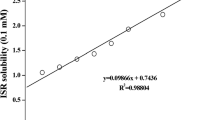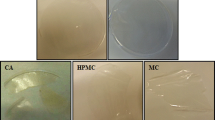Abstract
Orally dissolving films (ODFs) have received much attention as potential oral drug delivery systems for paediatric and geriatric patients, particularly those suffering from dysphagia. With their unique properties and advantages, the technology offers improved patient compliance and wider acceptability, eliminates the fear of choking, enables ease of administration and offers dosing convenience, without the requirement of water. However, adequate drug loading remains a challenge. The aim of this study was to mechanistically design and evaluate fast and extended release ODF formulations with high drug loading capacity, displaying good physicochemical and mechanical properties, as a potential dosage form for paediatric and geriatric use employing a slightly soluble model drug—ibuprofen. Different polymers (0.6–10% HPMC, 0.6–1.5% guar gum), plasticisers (0.1–0.5% glycerine, 0.1% sorbitol) and processing conditions (40–60°C drying temperatures, 8–16 h drying times) were investigated to produce films using the solvent casting method. Molecular compatibility was assessed using TGA, XRD and FTIR whereas film topography was assessed using SEM. Maximum ibuprofen load in single films was 20.7 mg/film (54.4%) and released 100% drug content in 5 min, while triple layered ibuprofen-loaded films contained 62.2 mg/film and released 100% drug release in 1 h. The ODFs demonstrated good disintegration time using low volume artificial saliva media and high dosage from uniformity. This study provides a mechanistic insight to the design and evaluation of fast and extended release ODFs with high drug loading, suitable for administration to paediatric and geriatric patients.












Similar content being viewed by others
References
Mandeep K, Rana AC, Nimrata S. Fast dissolving films : an innovative drug delivery system 2013;2(1):14–24.
Bhyan B, Jangra S, Kaur M, Singh H. Orally fast dissolving films: innovations in formulation and technology. Int J Pharm Sci Rev Res. 2011;9(2):9–15.
Preis M. Orally disintegrating films and mini-tablets—innovative dosage forms of choice for pediatric use. AAPS PharmSciTech. 2015;16(2):234–41. Available from:. https://doi.org/10.1208/s12249-015-0313-1.
Irfan M, Rabel S, Bukhtar Q, Imran M, Jabeen F, Khan A. Orally disintegrating films: a modern expansion in drug delivery system. Saudi Pharm J. 2016;24(5):537–46.
Londhe V, Shirsat R. Formulation and characterization of fast-dissolving sublingual film of iloperidone using Box–Behnken design for enhancement of oral bioavailability. AAPS PharmSciTech. 2018;19(3):1392–400. Available from:. https://doi.org/10.1208/s12249-018-0954-y.
Montenegro-Nicolini M, Morales JO. Overview and future potential of buccal mucoadhesive films as drug delivery systems for biologics. AAPS PharmSciTech. 2017;18(1):3–14. Available from:. https://doi.org/10.1208/s12249-016-0525-z.
Gala RP, Popescu C, Knipp GT, McCain RR, Ubale RV, Addo R, et al. Physicochemical and preclinical evaluation of a novel buccal measles vaccine. AAPS PharmSciTech. 2017;18(2):283–92. Available from:. https://doi.org/10.1208/s12249-016-0566-3.
El-Setouhy DA, El-Malak NSA. Formulation of a novel tianeptine sodium orodispersible film. AAPS PharmSciTech. 2010;11(3):1018–25.
Song Q, Guo X, Sun Y, Yang M. Anti-solvent precipitation method coupled electrospinning process to produce poorly water-soluble drug-loaded orodispersible films. AAPS PharmSciTech. 2019;20(7):273. Available from:. https://doi.org/10.1208/s12249-019-1464-2.
Alsofany JM, Hamza MY, Abdelbary AA. Fabrication of nanosuspension directly loaded fast-dissolving films for enhanced oral bioavailability of olmesartan medoxomil: in vitro characterization and pharmacokinetic evaluation in healthy human volunteers. AAPS PharmSciTech. 2018;19(5):2118–32. Available from:. https://doi.org/10.1208/s12249-018-1015-2.
Patil P, Shrivastava SK. Fast dissolving oral films: a novel drug delivery system. Int J Sci Res. 2014;3(7):2088–93.
Preis M, Pein M, Breitkreutz J. Development of a taste-masked orodispersible film containing dimenhydrinate 2012;4(4):551–62.
Hirpara F, Debnath SK, Saisivam S. Optimization & screening of different film forming polymers and plasticizers in fast dissolving sublingual film. Int J Pharm Pharm Sci. 2014;6(6):41–2.
ElMeshad AN, El Hagrasy AS. Characterization and optimization of orodispersible mosapride film formulations. AAPS PharmSciTech. 2011;12(4):1384–92.
Thakur N, Bansal M, Sharma N. Overview “a novel approach of fast dissolving films and their patients.” 2013;7(2):50–8.
Kande KV, Kotak DJ, Degani MS, Kirsanov D, Legin A, Devarajan PV. Microwave-assisted development of orally disintegrating tablets by direct compression. AAPS PharmSciTech. 2017;18(6):2055–66. Available from:. https://doi.org/10.1208/s12249-016-0683-z.
Sharma D, Kaur D, Verma S, Singh D, Singh M, Singh G. Fast dissolving oral films technology: a recent trend for an innovative oral drug delivery system. Int J Drug Deliv. 2015;7:60–75.
Tomar A, Sharma K, Chauhan NS, Mittal A, Bajaj U. Formulation and evaluation of fast dissolving oral film of dicyclomine as potential route of buccal delivery. Int J Drug Dev Res. 2012;4(2):408–17.
Borges AF, Silva C, Coelho JFJ, Simões S. Oral films: current status and future perspectives: I—galenical development and quality attributes. J Control Release. 2015;206:1–19.
Kulkarni A, Deokule H, Mane M, Ghadge D. Exploration of different polymers for use in the formulation of oral fast dissolving strips. J Curr Pharm Res. 2010;2(1):33–5.
Dixit RP, Puthli SP. Oral strip technology: overview and future potential. J Control Release. 2009;139(2):94–107.
Dahmash EZ, Al-Khattawi A, Iyire A, Al-Yami H, Dennison TJ, Mohammed AR. Quality by design (QbD) based process optimisation to develop functionalised particles with modified release properties using novel dry particle coating technique. PLoS One. 2018;13(11):e0206651.
Ding C, Zhang M, Li G. Preparation and characterization of collagen/hydroxypropyl methylcellulose (HPMC) blend film. Carbohydr Polym. 2015;119:194–201 Available from: http://www.sciencedirect.com/science/article/pii/S0144861714011709.
Liew K Bin, Tze Y, Tan F, Peh KK. Characterization of oral disintegrating film containing donepezil for Alzheimer disease 2012;13(1):134–42.
FDA. Food Additive Status List [Internet]. 2019 [cited 2020 Feb 16]. Available from: https://www.fda.gov/food/food-additives-petitions/food-additive-status-list#ftnG.
Cervera MF, Heinämäki J, Krogars K, Jörgensen AC, Karjalainen M, Colarte AI, et al. Solid-state and mechanical properties of aqueous chitosan-amylose starch films plasticized with polyols. AAPS PharmSciTech. 2004;5(1):109.
ICH. Validation of analytical procedures: text and methodology Q2(R1). Int Conf Harmon Tech Requir Regist Pharm Hum Use [Internet]. 2005;4. Available from: https://www.ich.org/fileadmin/Public_Web_Site/ICH_Products/Guidelines/Quality/Q2_R1/Step4/Q2_R1__Guideline.pdf.
Koland M, Charyulu RN, Vijayanarayana K, Prabhu P. In vitro and in vivo evaluation of chitosan buccal films of ondansetron hydrochloride. Int J Pharm Investig. 2011;1(3):164–71.
Ph.Eur. European pharmacopoeia. Vol. 1. Council of Europe; 2010.
Saab M, Mehanna MM. Disintegration time of orally dissolving films: various methodologies and in-vitro/in-vivo correlation. Die Pharm Int J Pharm Sci. 2019;74(4):227–30.
USP-35. The United States pharmacopeia: the National Formulary : USP 35 NF 30th Edition. Authority of the United States Pharmacopeial Convention I, editor. Washington, D.C. Rockville: USP, C. (2011). The United States Pharmacopeia. National Formulary.; 2011.
Bala R, Khanna S, Pawar P, Arora S. Orally dissolving strips: a new approach to oral drug delivery system. Int J Pharm Investig. 2013;3(2):67–76.
Lesko SM, Mitchell AA. An assessment of the safety of pediatric ibuprofen: a practitioner-based randomized clinical trial. Jama. 1995;273(12):929–33.
Baloğlu E, Karavana SY, Hyusein IY, Köse T. Design and formulation of Mebeverine HCl semisolid formulations for intraorally administration. AAPS PharmSciTech. 2010;11(1):181–8. Available from:. https://doi.org/10.1208/s12249-009-9374-3.
Liu ZQ, Yi X-S, Feng Y. Effects of glycerin and glycerol monostearate on performance of thermoplastic starch. J Mater Sci. 2001;36(7):1809–15.
Crnkovic PM, Koch C, Ávila I, Mortari DA, Cordoba AM, Moreira dos Santos A. Determination of the activation energies of beef tallow and crude glycerin combustion using thermogravimetry. Biomass and Bioenergy. 2012;44:8–16 Available from: http://www.sciencedirect.com/science/article/pii/S0961953412001845.
Dian L, Yang Z, Li F, Wang Z, Pan X, Peng X, et al. Cubic phase nanoparticles for sustained release of ibuprofen: formulation, characterization, and enhanced bioavailability study. Int J Nanomedicine. 2013;8:845.
Storey RA, Ymén I. Solid state characterization of pharmaceuticals. John Wiley & Sons; 2011.
Funding
Isra University (Jordan) provided funding for Gailany Ouda towards his MSc. Najran University and Aston University provided financial support to Hamad Alyami and Affiong Iyrie work in this research, respectively.
Author information
Authors and Affiliations
Corresponding author
Ethics declarations
Conflict of Interest
The authors declare that they have no conflict of interest.
Additional information
Publisher’s Note
Springer Nature remains neutral with regard to jurisdictional claims in published maps and institutional affiliations.
Rights and permissions
About this article
Cite this article
Ouda, G.I., Dahmash, E.Z., Alyami, H. et al. A Novel Technique to Improve Drug Loading Capacity of Fast/Extended Release Orally Dissolving Films with Potential for Paediatric and Geriatric Drug Delivery. AAPS PharmSciTech 21, 126 (2020). https://doi.org/10.1208/s12249-020-01665-5
Received:
Accepted:
Published:
DOI: https://doi.org/10.1208/s12249-020-01665-5




